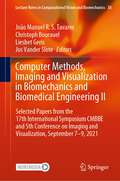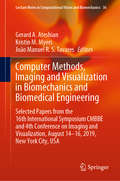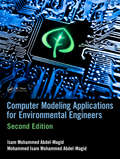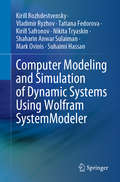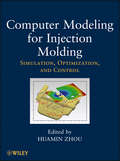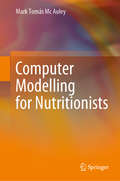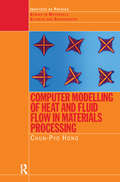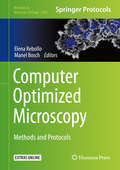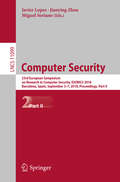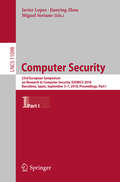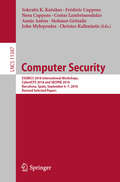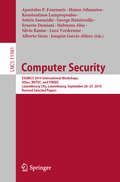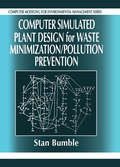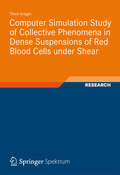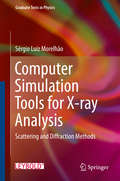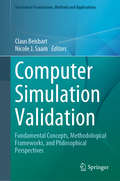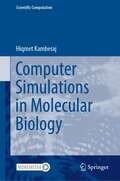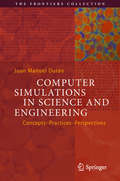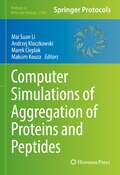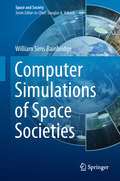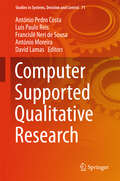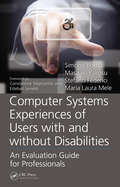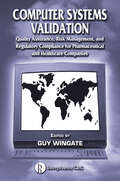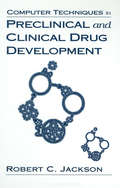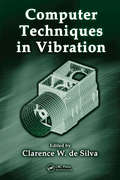- Table View
- List View
Computer Methods, Imaging and Visualization in Biomechanics and Biomedical Engineering II: Selected Papers from the 17th International Symposium CMBBE and 5th Conference on Imaging and Visualization, September 7-9, 2021 (Lecture Notes in Computational Vision and Biomechanics #38)
by João Manuel R. S. Tavares Liesbet Geris Christoph Bourauel Jos Vander SloteThis book gathers selected, extended and revised contributions to the 17th International Symposium on Computer Methods in Biomechanics and Biomedical Engineering and the 5th Conference on Imaging and Visualization (CMBBE 2021), held online on September 7-9, 2021, from Bonn, Germany. It reports on cutting-edge models, algorithms and imaging techniques for studying cells, tissues and organs in normal and pathological conditions. It covers numerical and machine learning methods, finite element modeling and virtual reality techniques, applied to understand biomechanics of movement, fluid and soft tissue biomechanics. It also reports on related advances in rehabilitation, surgery and diagnosis. All in all, this book offers a timely snapshot of the latest research and current challenges at the interface between biomedical engineering, computational biomechanics and biological imaging. Thus, it is expected to provide a source of inspiration for future research and cross-disciplinary collaborations.
Computer Methods, Imaging and Visualization in Biomechanics and Biomedical Engineering: Selected Papers from the 16th International Symposium CMBBE and 4th Conference on Imaging and Visualization, August 14-16, 2019, New York City, USA (Lecture Notes in Computational Vision and Biomechanics #36)
by João Manuel R. S. Tavares Gerard A. Ateshian Kristin M. MyersThis book gathers selected, extended and revised contributions to the 16th International Symposium on Computer Methods in Biomechanics and Biomedical Engineering, and the 4th Conference on Imaging and Visualization (CMBBE 2019), held on August 14-16, 2019, in New York City, USA. It reports on cutting-edge models and algorithms for studying various tissues and organs in normal and pathological conditions; innovative imaging and visualization techniques; and the latest diagnostic tools. Further topics addressed include: numerical methods, machine learning approaches, FEM models, and high-resolution imaging and real-time visualization methods applied for biomedical purposes. Given the scope of its coverage, the book provides graduate students and researchers with a timely and insightful snapshot of the latest research and current challenges in biomedical engineering, computational biomechanics and biological imaging, as well as a source of inspiration for future research and cross-disciplinary collaborations.
Computer Modeling Applications for Environmental Engineers
by Isam Mohammed Abdel-Magid Ahmed Mohammed Isam Mohammed Abdel-MagidComputer Modeling Applications for Environmental Engineers in its second edition incorporates changes and introduces new concepts using Visual Basic.NET, a programming language chosen for its ease of comprehensive usage. This book offers a complete understanding of the basic principles of environmental engineering and integrates new sections that address Noise Pollution and Abatement and municipal solid-waste problem solving, financing of waste facilities, and the engineering of treatment methods that address sanitary landfill, biochemical processes, and combustion and energy recovery. Its practical approach serves to aid in the teaching of environmental engineering unit operations and processes design and demonstrates effective problem-solving practices that facilitate self-teaching. A vital reference for students and professional sanitary and environmental engineers this work also serves as a stand-alone problem-solving text with well-defined, real-work examples and explanations.
Computer Modeling and Simulation of Dynamic Systems Using Wolfram SystemModeler
by Shaharin Anwar Sulaiman Kirill Rozhdestvensky Vladimir Ryzhov Tatiana Fedorova Kirill Safronov Nikita Tryaskin Mark Ovinis Suhaimi HassanThis book briefly discusses the main provisions of the theory of modeling. It also describes in detail the methodology for constructing computer models of dynamic systems using the Wolfram visual modeling environment, SystemModeler, and provides illustrative examples of solving problems of mechanics and hydraulics. Intended for students and professionals in the field, the book also serves as a supplement to university courses in modeling and simulation of dynamic systems.
Computer Modeling for Injection Molding
by Huamin ZhouThis book covers a wide range of applications and uses of simulation and modeling techniques in polymer injection molding, filling a noticeable gap in the literature of design, manufacturing, and the use of plastics injection molding. The authors help readers solve problems in the advanced control, simulation, monitoring, and optimization of injection molding processes. The book provides a tool for researchers and engineers to calculate the mold filling, optimization of processing control, and quality estimation before prototype molding.
Computer Modelling for Nutritionists
by Mark Tomás Mc AuleyThis book draws on Mark Mc Auley’s wealth of experience to provide an intuitive step-by-step guide to the modelling process. It also provides case studies detailing the creation of biological process models. Mark Mc Auley has over 15 years’ experience of applying computing to challenges in bioscience. Currently he is employed as a Senior Lecturer in Chemical Engineering at the University of Chester. He has published widely on the use of computer modelling in nutrition and uses computer modelling to both enhance and enrich the learning experience of the students that he teaches. He has taught computer modelling to individuals at a wide variety of levels and from different backgrounds, from undergraduate nutrition students to PhD and medical students.
Computer Modelling of Heat and Fluid Flow in Materials Processing (Series In Materials Science And Engineering Ser.)
by C.P. HongThe understanding and control of transport phenomena in materials processing play an important role in the improvement of conventional processes and in the development of new techniques. Computer modeling of these phenomena can be used effectively for this purpose. Although there are several books in the literature covering the analysis of heat tra
Computer Optimized Microscopy: Methods and Protocols (Methods in Molecular Biology #2040)
by Elena Rebollo Manel BoschThis volume explores open-source based image analysis techniques to provide a state-of-the-art collection of workflows covering current bioimage analysis problematics, including colocalization, particle counting, 3D structural analysis, ratio imaging and FRET quantification, particle tracking, high-content screening or machine learning. Written in the highly successful Methods in Molecular Biology series format, chapters include introductions to their respective topics, lists of the necessary materials and scripts, step-by-step, readily reproducible image analysis protocols, and tips on troubleshooting and avoiding known pitfalls.Comprehensive and cutting-edge, Computer Optimized Microscopy: Methods and Protocols is a valuable resource for both novice and experienced researchers who are interested in learning more about this developing field.
Computer Security: 14th International Conference, Isc 2011, Xi'an, China, October 26-29, 2011, Proceedings (Lecture Notes In Computer Science / Security And Cryptology Ser. #3650)
by Javier Lopez Jianying Zhou Miguel SorianoThe two-volume set, LNCS 11098 and LNCS 11099 constitutes the refereed proceedings of the 23nd European Symposium on Research in Computer Security, ESORICS 2018, held in Barcelona, Spain, in September 2018.The 56 revised full papers presented were carefully reviewed and selected from 283 submissions. The papers address issues such as software security, blockchain and machine learning, hardware security, attacks, malware and vulnerabilities, protocol security, privacy, CPS and IoT security, mobile security, database and web security, cloud security, applied crypto, multi-party computation, SDN security.
Computer Security: 14th International Conference, Isc 2011, Xi'an, China, October 26-29, 2011, Proceedings (Lecture Notes In Computer Science / Security And Cryptology Ser. #3650)
by Javier Lopez Jianying Zhou Miguel SorianoThe two-volume set, LNCS 11098 and LNCS 11099 constitutes the refereed proceedings of the 23nd European Symposium on Research in Computer Security, ESORICS 2018, held in Barcelona, Spain, in September 2018.The 56 revised full papers presented were carefully reviewed and selected from 283 submissions. The papers address issues such as software security, blockchain and machine learning, hardware security, attacks, malware and vulnerabilities, protocol security, privacy, CPS and IoT security, mobile security, database and web security, cloud security, applied crypto, multi-party computation, SDN security.
Computer Security: ESORICS 2018 International Workshops, CyberICPS 2018 and SECPRE 2018, Barcelona, Spain, September 6–7, 2018, Revised Selected Papers (Lecture Notes in Computer Science #11387)
by John Mylopoulos Frédéric Cuppens Costas Lambrinoudakis Sokratis K. Katsikas Nora Cuppens Christos Kalloniatis Annie Antón Stefanos GritzalisThis book constitutes the thoroughly refereed post-conference proceedings of the 4th International Workshop on the Security of Industrial Control Systems and Cyber-Physical Systems, CyberICPS 2018, and the Second International Workshop on Security and Privacy Requirements Engineering, SECPRE 2018, held in Barcelona, Spain, in September 2018, in conjunction with the 23rd European Symposium on Research in Computer Security, ESORICS 2018. The CyberICPS Workshop received 15 submissions from which 8 full papers were selected for presentation. They cover topics related to threats, vulnerabilities and risks that cyber-physical systems and industrial control systems face; cyber attacks that may be launched against such systems; and ways of detecting and responding to such attacks. From the SECPRE Workshop 5 full papers out of 11 submissions are included. The selected papers deal with aspects of security and privacy requirements assurance and evaluation; and security requirements elicitation and modelling.
Computer Security: ESORICS 2019 International Workshops, IOSec, MSTEC, and FINSEC, Luxembourg City, Luxembourg, September 26–27, 2019, Revised Selected Papers (Lecture Notes in Computer Science #11981)
by Joaquin Garcia-Alfaro Silvio Ranise Ernesto Damiani Sotiris Ioannidis Apostolos P. Fournaris Konstantinos Lampropoulos Manos Athanatos George Hatzivasilis Habtamu Abie Luca Verderame Alberto SienaThis book constitutes the refereed post-conference proceedings of the Second International Workshop on Information & Operational Technology (IT & OT) security systems, IOSec 2019 , the First International Workshop on Model-driven Simulation and Training Environments, MSTEC 2019, and the First International Workshop on Security for Financial Critical Infrastructures and Services, FINSEC 2019, held in Luxembourg City, Luxembourg, in September 2019, in conjunction with the 24th European Symposium on Research in Computer Security, ESORICS 2019. The IOSec Workshop received 17 submissions from which 7 full papers were selected for presentation. They cover topics related to security architectures and frameworks for enterprises, SMEs, public administration or critical infrastructures, threat models for IT & OT systems and communication networks, cyber-threat detection, classification and pro ling, incident management, security training and awareness, risk assessment safety and security, hardware security, cryptographic engineering, secure software development, malicious code analysis as well as security testing platforms. From the MSTEC Workshop 7 full papers out of 15 submissions are included. The selected papers deal focus on the verification and validation (V&V) process, which provides the operational community with confidence in knowing that cyber models represent the real world, and discuss how defense training may benefit from cyber models. The FINSEC Workshop received 8 submissions from which 3 full papers and 1 short paper were accepted for publication. The papers reflect the objective to rethink cyber-security in the light of latest technology developments (e.g., FinTech, cloud computing, blockchain, BigData, AI, Internet-of-Things (IoT), mobile-first services, mobile payments).
Computer Simulated Plant Design for Waste Minimization/Pollution Prevention (Computer Modeling for Environmental Management)
by Stan BumbleFull of examples based on case studies from a variety of industries, Computer Simulated Plant Design for Waste Minimization/Pollution Prevention discusses preventing pollution and minimizing waste using computer simulation programs. The author examines the computer technologies used in the field, including the design and analysis of computer-aided flow sheets. With this book, readers will understand how to use computer technology to design plants that generate little or no pollution and how to use information generated by computer simulations for technical data in proposals and presentations and as the basis for making policy decisions.
Computer Simulation Study of Collective Phenomena in Dense Suspensions of Red Blood Cells under Shear
by Timm KrügerThe rheology of dense red blood cell suspensions is investigated via computer simulations based on the lattice Boltzmann, the immersed boundary, and the finite element methods. The red blood cells are treated as extended and deformable particles immersed in the ambient fluid. In the first part of the work, the numerical model and strategies for stress evaluation are discussed. In the second part, the behavior of the suspensions in simple shear flow is studied for different volume fractions, particle deformabilities, and shear rates. Shear thinning behavior is recovered. The existence of a shear-induced transition from a tumbling to a tank-treading motion is demonstrated. The transition can be parameterized by a single quantity, namely the effective capillary number. It is the ratio of the suspension stress and the characteristic particle membrane stress. At the transition point, a strong increase in the orientational order of the red blood cells and a significant decrease of the particle diffusivity are observed. However, the average cell deformation shows no signature of the transition.
Computer Simulation Tools for X-ray Analysis: Scattering and Diffraction Methods (Graduate Texts in Physics)
by Sérgio Luiz MorelhãoThis book teaches the users on how to construct a library of routines to simulate scattering and diffraction by almost any kind of samples. The main goal of this book is to break down the huge barrier of difficulties faced by beginners from many fields (Engineering, Physics, Chemistry, Biology, Medicine, Material Science, etc. ) in using X-rays as an analytical tool in their research. Besides fundamental concepts, MatLab routines are provided, showing how to test and implement the concepts. The major difficult in analysing materials by X-ray techniques is that it strongly depends on simulation software. This book teaches the users on how to construct a library of routines to simulate scattering and diffraction by almost any kind of samples. It provides to a young student the knowledge that would take more than 20 years to acquire by working on X-rays and relying on the available textbooks. The scientific productivity worldwide is growing at a breakneck pace, demanding ever more dynamic approaches and synergies between different fields of knowledge. To master the fundamentals of X-ray physics means the opportunity of working at an infiniteness of fields, studying systems where the organizational understanding of matter at the atomic scale is necessary. Since the discovery of X radiation, its usage as investigative tool has always been under fast expansion afforded by instrumental advances and computational resources. Developments in medical and technological fields have, as one of the master girders, the feasibility of structural analysis offered by X-rays. One of the major difficulties faced by beginners in using this fantastic tool lies in the analysis of experimental data. There are only few cases where it is possible to extract structural information directly from experiments. In most cases, structure models and simulation of radiation-matter interaction processes are essential. The advent of intense radiation sources and rapid development of nanotechnology constantly creates challenges that seek solutions beyond those offered by standard X-ray techniques. Preparing new researchers for this scenario of rapid and drastic changes requires more than just teaching theories of physical phenomena. It also requires teaching of how to implement them in a simple and efficient manner. In this book, fundamental concepts in applied X-ray physics are demonstrated through available computer simulation tools. Using MatLab, more than eighty routines are developed for solving the proposed exercises, most of which can be directly used in experimental data analysis. Therefore, besides X-ray physics, this book offers a practical programming course in modern high-level language, with plenty of graphic and mathematical tools.
Computer Simulation Validation: Fundamental Concepts, Methodological Frameworks, and Philosophical Perspectives (Simulation Foundations, Methods and Applications)
by Claus Beisbart Nicole J. SaamThis unique volume introduces and discusses the methods of validating computer simulations in scientific research. The core concepts, strategies, and techniques of validation are explained by an international team of pre-eminent authorities, drawing on expertise from various fields ranging from engineering and the physical sciences to the social sciences and history. The work also offers new and original philosophical perspectives on the validation of simulations.Topics and features: introduces the fundamental concepts and principles related to the validation of computer simulations, and examines philosophical frameworks for thinking about validation; provides an overview of the various strategies and techniques available for validating simulations, as well as the preparatory steps that have to be taken prior to validation; describes commonly used reference points and mathematical frameworks applicable to simulation validation; reviews the legal prescriptions, and the administrative and procedural activities related to simulation validation; presents examples of best practice that demonstrate how methods of validation are applied in various disciplines and with different types of simulation models; covers important practical challenges faced by simulation scientists when applying validation methods and techniques; offers a selection of general philosophical reflections that explore the significance of validation from a broader perspective.This truly interdisciplinary handbook will appeal to a broad audience, from professional scientists spanning all natural and social sciences, to young scholars new to research with computer simulations. Philosophers of science, and methodologists seeking to increase their understanding of simulation validation, will also find much to benefit from in the text.
Computer Simulations in Molecular Biology (Scientific Computation)
by Hiqmet KamberajThis book covers a range of topics in quantum mechanics and molecular dynamics simulation, including computational modeling and machine learning approaches. The book also provides a Python GUI and tutorials for simulating molecular biological systems and presents case studies of quantum mechanics simulations for predicting electronic properties. Its pedagogical formatting makes it easy for students to understand and follow and has been praised for providing clear and detailed explanations of complex topics. This book is ideal for graduate students and researchers in theoretical and computational biophysics, physics, chemistry, and materials science, as well as postgraduates in applied mathematics, computer science, and bioinformatics.
Computer Simulations in Science and Engineering: Concepts - Practices - Perspectives (The Frontiers Collection)
by Juan Manuel DuránThis book addresses key conceptual issues relating to the modern scientific and engineering use of computer simulations. It analyses a broad set of questions, from the nature of computer simulations to their epistemological power, including the many scientific, social and ethics implications of using computer simulations. The book is written in an easily accessible narrative, one that weaves together philosophical questions and scientific technicalities. It will thus appeal equally to all academic scientists, engineers, and researchers in industry interested in questions (and conceivable answers) related to the general practice of computer simulations.
Computer Simulations of Aggregation of Proteins and Peptides (Methods in Molecular Biology #2340)
by Andrzej Kloczkowski Mai Suan Li Marek Cieplak Maksim KouzaThis volume provides computational methods and reviews various aspects of computational studies of protein aggregation. Chapters discuss the relationship between protein misfolding and protein aggregation, methods of prediction of aggregation propensities of protein, peptides, protein structure, results of computer simulations of aggregation, and computational simulations focused on specific diseases such as Alzheimer’s, Parkinson’s, and preeclampsia. Written in the highly successful Methods in Molecular Biology series format, chapters include introductions to their respective topics, lists of the necessary materials and reagents, step-by-step, readily reproducible laboratory protocols, and tips on troubleshooting and avoiding known pitfalls. Authoritative and cutting-edge, Computer Simulations of Aggregation of Proteins and Peptides aims to ensure successful results in the further study of this vital field.
Computer Simulations of Space Societies (Space and Society)
by William Sims BainbridgeAt the intersection of astronautics, computer science, and social science, this book introduces the challenges and insights associated with computer simulation of human society in outer space, and of the dynamics of terrestrial enthusiasm for space exploration. Never before have so many dynamic representations of space-related social systems existed, some deeply analyzing the logical implications of social-scientific theories, and others open for experience by the general public as computer-generated virtual worlds. Fascinating software ranges from multi-agent artificial intelligence models of civilization, to space-oriented massively multiplayer online games, to educational programs suitable for schools or even for the world's space exploration agencies. At the present time, when actual forays by humans into space are scarce, computer simulations of space societies are an excellent way to prepare for a renaissance of exploration beyond the bounds of Earth.
Computer Supported Qualitative Research (Studies in Systems, Decision and Control #71)
by António Moreira António Pedro Pedro Costa Luís Paulo Paulo Reis Francislê Neri de Sousa David LamasThis book contains an edited selection of the papers accepted for presentation and discussion at the first International Symposium on Qualitative Research (ISQR2016), held in Porto, Portugal, July 12th-14th, 2016. The book and the symposium features the four main application fields Education, Health, Social Sciences and Engineering and Technology and seven main subjects: Rationale and Paradigms of Qualitative Research (theoretical studies, critical reflection about epistemological dimensions, ontological and axiological); Systematization of approaches with Qualitative Studies (literature review, integrating results, aggregation studies, meta -analysis, meta- analysis of qualitative meta- synthesis, meta- ethnography); Qualitative and Mixed Methods Research (emphasis in research processes that build on mixed methodologies but with priority to qualitative approaches); Data Analysis Types (content analysis, discourse analysis, thematic analysis, narrative analysis, etc. ); Innovative processes of Qualitative Data Analysis (design analysis, articulation and triangulation of different sources of data images, audio, video); Qualitative Research in Web Context (eResearch, virtual ethnography, interaction analysis, latent corpus on the internet, etc. ); Qualitative Analysis with Support of Specific Software (usability studies, user experience, the impact of software on the quality of research. "
Computer Systems Experiences of Users with and Without Disabilities: An Evaluation Guide for Professionals (Rehabilitation Science in Practice Series)
by Masaaki Kurosu Stefano Federici Simone Borsci Maria Laura MeleThis book provides to manufacturers, designers and evaluation professionals the necessary tools for balancing design and the assessment phases during the product lifecycle. It proposes an integrated model of interaction evaluation for a holistic analysis of the user experience by both discussing in details the interaction testing methods, and promoting the involvement of disabled users in human computer interaction evaluation.
Computer Systems Validation: Quality Assurance, Risk Management, and Regulatory Compliance for Pharmaceutical and Healthcare Companies
by Guy WingateBoth pervasive and ubiquitous, computerized systems are now an integral component of every corporate strategy in pharmaceutical and healthcare companies. However, when technology is combined with high-risk public safety projects or the production and control of life-saving medicines or devices, it is necessary to ensure that it is reliable, quality
Computer Techniques in Preclinical and Clinical Drug Development
by Robert C. JacksonIt is estimated that 80 to 90% of drugs under development never make it to the marketplace due to insufficient clinical activity, unacceptable toxicity, rapid appearance of drug resistance, or other factors that should be, at least partially, predictable from preclinical testing. This new text asks the question, "How can we use computational method
Computer Techniques in Vibration
by Clarence W. de SilvaUnderstanding and controlling vibration is critical for reducing noise, improving work environments and product quality, and increasing the useful life of industrial machinery and other mechanical systems. Computer-based modeling and analytical tools provide fast, accurate, and efficient means of designing and controlling a system for improved vibr
